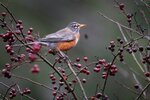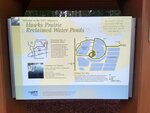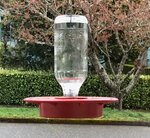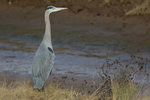




This morning, the cats woke me at 6:30 a.m., and as I stumbled around in semi-darkness, I heard a joyous song coming through the open window. It was an American Robin greeting the coming dawn. This reminded me to remind you about the coming dawn chorus, the early morning avian songfest that will be in full swing by the end of April. (Dawn is a reasonable 6:40 a.m. now, but by mid-May it will be 5:30, and in mid-June 4:30 – so better to investigate the dawn chorus now).
Robins are so common that we tend to not fully appreciate them. But their loud burbling song, sung throughout the day (and even after rain showers) serves to remind we busy humans to pay attention to the natural world and the changing of the seasons. It’s as if they are saying: “Hey, pay attention to me! I’m ready for spring!”
Another favorite early spring singer is the Pacific Wren (formerly called the Winter Wren because these males occasionally sing through the winter). This species lives in the woodlands and sings a joyous trilling song with many different notes, lasting 5-10 seconds. You will find this bird near the ground in forested habitat. They are very small and brown, with a thin bill and sharply upturned tail. They readily respond if you make “phishing” sounds so, give it a try! They just might come close and give you a great view.
Near my house I have good breeding habitat for both species of chickadees, Black-capped and Chestnut-backed. Both species have a similar chickadee-dee-dee call that you might year around. In spring, starting now, male Black-caps sing a distinct 3-4 note song on the same pitch. It sounds so different from the call that it might take a while to figure out who’s singing. Chestnut-backed Chickadees, in contrast, don’t have much of a song at all.
A reader reminded me to again mention the nesting Great Blue Herons nesting in downtown Olympia. Their nests are in a small conifer grove along Capitol Way just south of the Farmers Market roundabout. Right now, they are raucously competing for nesting sites and adding new sticks to old nests that survived winter storms. Soon there will be eggs in those nests and, by early summer, noisy young birds demanding food from their parents. If you visit the market regularly, you might enjoy monitoring the birds’ nesting progress.
Hummingbirds are very active now, attending to blooming salmonberry and red-flowering currant. You know, it’s never too late to put up a hummingbird feeder. These little avian jewels are not afraid, and if you place your feeder close to a window, you might get some up-close visitors. Both species, Rufous and Anna’s, are around. As their name suggests, the Rufous species always has a rusty reddish appearance. The Anna’s are green, and the males have a bight rosy-pink throat and crest. Sometimes the hummers can be fooled by window reflections and hit the window; if this happens, you will need to put up some sort of material on the window, inside or outside, that disrupts the reflection and warns away the birds.
Hummingbirds feed on flower nectar (and the sugar water in feeders, of course). But much of their food intake actually comes from very small flying insects. Besides flower nectar, these birds are just as interested in the small insects around these flowers. In May, when Madrona trees are in bloom, they attract multitudes of insects and, at times, you might notice multiple hummingbirds attending the same trees. It’s the insects that are drawing them in.
Many of our local birds have not yet settled down to breed. The Dark-eyed Juncos are still hanging out in small flocks, invading bird-feeding sites that are still being maintained. There are lots of swallows flying around in mixed-species flocks. If there are swallows, it’s a sure sign that insects are abundant.
There’s a good and underappreciated birding site you should know about. It’s LOTT’s Hawks Prairie Reclaimed Water Ponds, located at 3001 Hogum Bay Rd. This 41-acre site has many things that attract birds. There are the ponds, of course, but there’s also a small, forested area and all kinds of brushy habitat around the ponds.
The gravel walking paths are level and easy walking, and there are several pond overlooks. This would be a good place to visit every week or so just to document for yourself how spring is progressing in the natural world. Over the next month, more and more bird species will be using this site. It’s easy to reach from just north of I-5, Exit 111; it has a good parking lot and is almost never crowded. And, as a bonus, you can familiarize yourself with how we in Thurston County are returning treated wastewater to the aquifer.
George Walter is environmental program manager at the Nisqually Indian Tribe’s natural resources department; he also has a 40+ year interest in bird watching. He may be reached at george@theJOLTnews.com
Photos for this column are provided by Liam Hutcheson, a 16-year-old Olympia area birder and avid photographer.
1 comment on this item Please log in to comment by clicking here
Terrilovesanimals
Thank you for this! I love all the birds! Going to have to make it down to see the Blue Herons! I love all the birds that come to my yard. I love looking at the different color patterns and also their songs.
Thursday, March 28 Report this